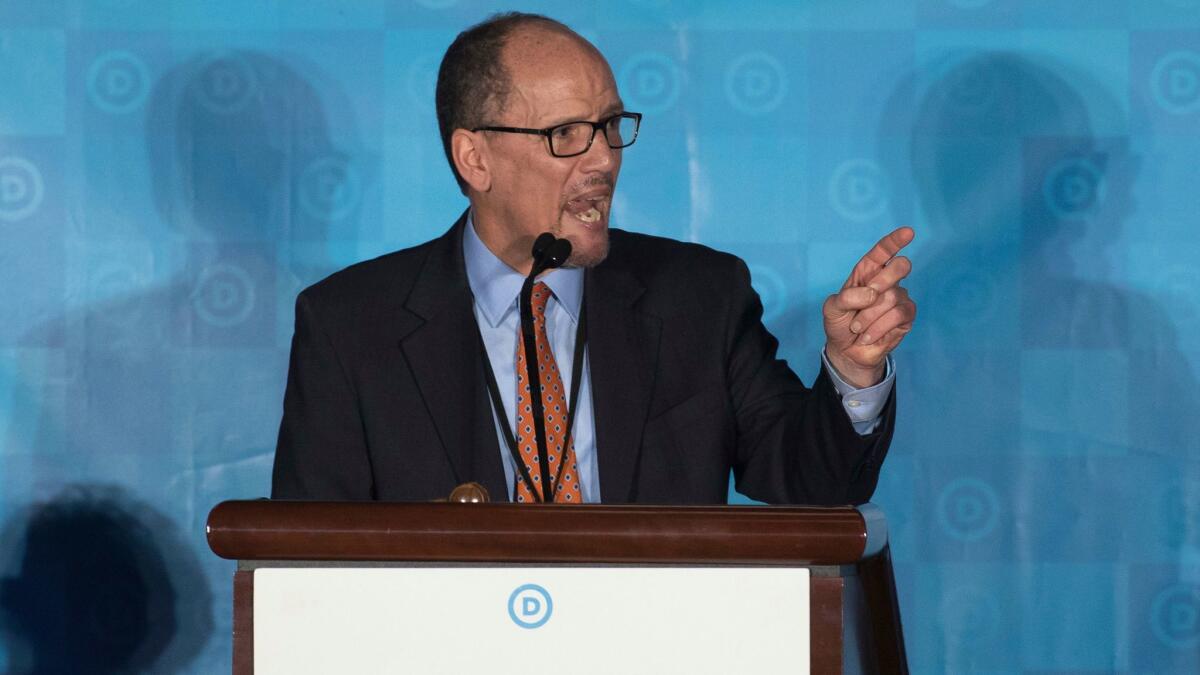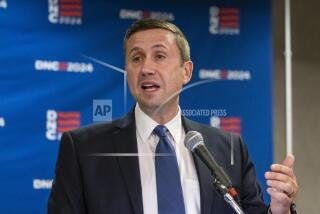New Democratic Party chief Tom Perez, with Ellison as deputy, vows to ‘take the fight’ to Trump

- Share via
Reporting from Atlanta — The Democratic Party put its faith in its old guard Saturday to guide it out of the political wilderness, choosing as its new leader an Obama-era Cabinet secretary over the charismatic congressman backed by the progressive wing of the party.
Tom Perez, a former secretary of Labor with strong ties to unions, persuaded the spirited assembly of party delegates in Atlanta that he can best help harness a grass-roots outpouring of anti-Trump protest and anger into a Democratic resurgence at the ballot box.
“We are suffering from a crisis of confidence, a crisis of relevance,” Perez told delegates before they chose him in a down-to-the-wire contest with Rep. Keith Ellison of Minnesota, whom the Bernie Sanders wing of the party had rallied around.
“We need a chair who can not only take the fight to Donald Trump.… We also need a chair who can lead a turnaround and change the culture of the Democratic Party,” Perez said.
President Trump tweeted his congratulations to Perez, adding “I could not be happier for him, or for the Republican Party!”
The ascendance of an establishment liberal is certain to renew tension between Democratic Party stalwarts and the unruly progressive movement aligned with Sen. Sanders of Vermont and Sen. Elizabeth Warren of Massachusetts, who both backed Ellison.
Some Ellison supporters erupted in protest as the final vote was announced.
Perez quickly sought to unite the party by naming Ellison his deputy chairman, a move unanimously approved by the 435 assembled delegates.
They had earlier supported Perez 235-200 in a second round of voting after several other candidates dropped out. Pete Buttigieg, the mayor of South Bend, Ind., had appeared a potential challenger but dropped out before the first round of voting.
Ellison urged supporters not to “waste even a moment going at it about who supported who.… We don’t have the luxury of going out of this room divided.”
Perez, who takes over from Donna Brazile and is the first Latino to lead the Democratic National Committee, will become the new face of the beleaguered party on cable news networks and at campaign rallies after a year that saw not only heavy losses at the ballot box but Russian government hacking aimed at DNC computers.
But tending the talk show circuit will be overshadowed by a much tougher and less glamorous job: repairing a party tattered by bickering factions, muddled messaging and neglect after eight years of the Obama administration.
Following the stunning GOP wave in the 2016 election, the Democratic Party is weaker than it has been in decades.
Republicans now hold not only the White House and both houses of Congress; they control 69 of the country’s 99 state legislative chambers and 33 governorships — including 25 states where they control both the governor’s office and the state legislature.
Perez was the favored choice of the Obama White House and the party establishment. He is a steady hand whose reorganization plans are ambitious but are not threatening to longtime party operatives.
Obama White House alums worked their connections in the states to garner delegate votes for him. Perez himself campaigned with a message similar to what Hillary Clinton used in her primary race against Sanders: He argued he was not just a progressive, but one who has gotten things done.
His victory was nonetheless a disappointment to the energetic movement Sanders inspired, which will be crucial to any successful effort at rebuilding the party and winning elections.
Progressive activists had seen the leadership race as an opportunity to take control of a party apparatus that has been hostile to their political vision. They had put their faith in Ellison to rebuild the party around the grass-roots organizing model Sanders harnessed during last year’s Democratic primaries.
Many were inspired by Ellison’s personal story as a minority politician whose majority-white, working-class district in Minneapolis elected him as the first Muslim member of Congress in 2007.
Sanders congratulated Perez in a statement that also warned, “It is imperative that Tom understands that the same-old, same-old is not working and that we must open the doors of the party to working people and young people in a way that has never been done before.”
The uneasiness of progressives was underscored by a floor fight that played out just before the chairperson vote, in which delegates voted against reinstating a ban on corporate donations to the party.
The advocacy group Move On also put Perez on notice that it expects him to change a party that “has become too Washington-insider, too beholden to the same big donors and consultants, and too timid on issues of social, racial, and economic justice.”
The leadership election did little to quiet the raging internal debate about what happened in November. There is no consensus about how Donald Trump smashed the so-called Blue Wall of Democratic strongholds and won state after state that the Democrats assumed were out of his reach.
Many progressives attribute the loss — and the erosion of power on the state level — to a weak message and failure to aggressively embrace a populist economic agenda, as well as a reluctance to embrace the identity politics that could energize minorities.
They say the white working-class Rust Belt voters who had backed Obama marked their ballots for Trump, or for third-party candidates, because they wanted big economic change, not more moderation.
Others in the party argue that’s a misreading of the election results, and that the path back to power for Democrats is not on the hard left.
Where Democrats fall in this debate guides how they approach upcoming elections. The party is grappling over how heavily to invest in recapturing voters it lost in the Midwest versus parts of the Southern states where minority populations are booming, and where Republicans are holding congressional seats in districts that Trump lost or just barely won.
But much of the work before Perez is even deeper in the weeds. He will have to rebuild the badly frayed network of state and county parties that form the backbone of the organization. Their disconnectedness to the Democratic National Committee and, in some cases, lack of persistent, steady management has become a major vulnerability.
He takes over the party at a difficult but also opportune time, amid the erupting anger over the direction Trump and the Republican-led Congress are taking the country.
Live updates from Washington »
Perez will need to move quickly to build the infrastructure needed to channel all that energy, and to keep it brewing through the next big election, which is still two years away.
Considering the party’s state of disarray, the leadership race was notable for its lack of public bloodletting.
The candidate forums were congenial, the campaign messaging polite — a reflection of the nature of this particular election, which is decided by party officials more preoccupied with nuts-and-bolts party business like resource allocation and how conventions will be run than with heady issues of ideology.
But simmering beneath the surface were tensions over how badly the party fared during the Obama years and who might be at fault. Perez was encouraged to run against Ellison by some Obama allies who stood to lose lucrative party contracts in a takeover by the Sanders faction.
Follow me: @evanhalper
ALSO
Trump’s top deputies hope to shore up ties with a suspicious Mexico
Whose news is fake? Here’s the latest in Trump’s war with the press
California Republicans mostly united behind Trump at state GOP convention
More to Read
Get the L.A. Times Politics newsletter
Deeply reported insights into legislation, politics and policy from Sacramento, Washington and beyond. In your inbox twice per week.
You may occasionally receive promotional content from the Los Angeles Times.











